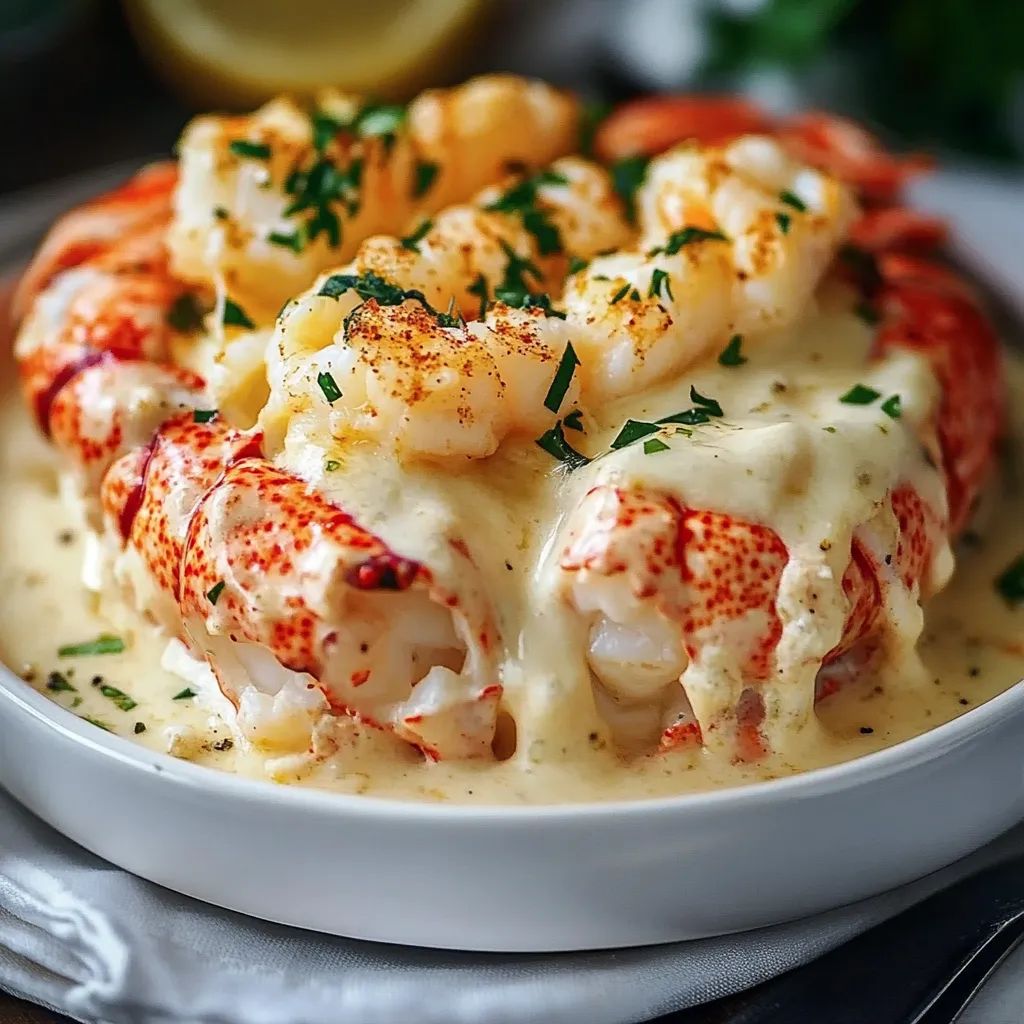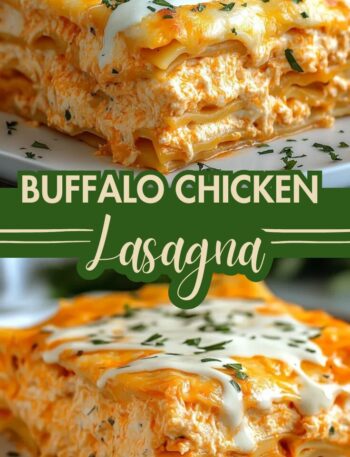
Indulge in timeless elegance with Classic Lobster Newburg, a luxurious dish that has graced fine dining tables for generations. Tender lobster meat is bathed in a rich, velvety cream sauce with a hint of sherry and a touch of spice, creating a symphony of flavors that’s both comforting and sophisticated.
Perfect for special occasions, this decadent recipe brings restaurant-quality taste right into your home kitchen.
Lobster Newburg is a legendary dish that dates back to the late 19th century, first served at Delmonico’s Restaurant in New York City. Known for its rich, velvety sauce and tender chunks of lobster, this indulgent seafood preparation quickly became synonymous with luxury dining.
At its heart, Lobster Newburg is about balancing the delicate sweetness of lobster meat with a luscious, sherry- or brandy-laced cream sauce enriched with egg yolks and butter. When served over toast points, puff pastry, or rice, it creates a dish that feels both sophisticated and deeply comforting.
This recipe captures the classic preparation, staying true to the original spirit while being approachable for the modern kitchen. Whether you’re making it for a holiday gathering, a dinner party, or a romantic meal at home, Lobster Newburg never fails to impress.
Whether served over puff pastry, toast, or rice, it’s sure to impress guests and delight your taste buds. Don’t just scroll—pin this now and treasure the recipe for your next unforgettable feast!
Rotisserie Chicken Tacos: An Amazing Ultimate Recipe
Description
Classic Lobster Newburg is a luxurious seafood dish that originated in the late 19th century and remains a symbol of fine dining.
Succulent chunks of lobster are gently simmered in a velvety, rich cream sauce infused with butter, egg yolks, sherry, and a hint of nutmeg, creating a decadent flavor profile.
Traditionally served over toast points or puff pastry shells, this dish balances elegance with indulgence.
Perfect for special occasions, Lobster Newburg highlights the natural sweetness of lobster while enhancing it with smooth, savory notes.
Its timeless appeal makes it a cherished recipe in classic American cuisine.
Ingredients
Instructions
-
Prepare the Lobster
If using whole lobsters, bring a large pot of salted water to a boil. Add the lobsters and cook for 8–10 minutes until shells are bright red. Remove and let cool slightly before cracking the shells. Extract the tail and claw meat, then chop it into bite-sized chunks. If using pre-cooked lobster meat, simply cut it into pieces and set aside. -
Make the Sauce Base
In a heavy skillet or sauté pan, melt the butter over medium heat. Once it begins to foam, add the lobster pieces and gently sauté for 2–3 minutes, just until heated through. Remove the lobster meat with a slotted spoon and keep warm. -
Create the Cream Mixture
To the same pan, add the sherry and cognac. Carefully tilt the pan to flambé (ignite) the alcohol if you’re comfortable doing so, or simply let it simmer until reduced by half. This step deepens the flavor and infuses the butter with aromatic notes. -
Season and Finish
In a mixing bowl, whisk the egg yolks and heavy cream together until smooth. Slowly add this mixture to the pan, whisking constantly to prevent curdling. Reduce the heat to low and stir gently until the sauce thickens enough to coat the back of a spoon. Do not let it boil, or the eggs may scramble. -
Serve
Once the sauce has thickened, season with salt, black pepper, cayenne, and nutmeg. Return the lobster meat to the pan and fold it into the sauce, allowing it to warm through for another 2 minutes. The result should be a silky, golden-hued sauce clinging to each tender piece of lobster. -
Spoon the Lobster Newburg over warm toast points, inside crisp puff pastry shells, or atop a bed of fluffy rice. Garnish with a sprinkle of fresh parsley for color and a touch of freshness. Serve immediately while hot.
Nutrition Facts
Servings 4
- Amount Per Serving
- Calories 450kcal
- % Daily Value *
- Total Fat 22g34%
- Saturated Fat 18g90%
- Cholesterol 350mg117%
- Sodium 800mg34%
- Total Carbohydrate 8g3%
- Sugars 3g
- Protein 22g44%
* Percent Daily Values are based on a 2,000 calorie diet. Your daily value may be higher or lower depending on your calorie needs.
Note
Classic Lobster Newburg: Tips and Serving Tricks
Few dishes carry the same luxurious reputation as Lobster Newburg. This timeless seafood creation, originating in the 19th century, is a rich combination of lobster meat, butter, egg yolks, cream, and sherry or cognac.
Its velvety sauce draped over tender chunks of lobster makes it a dish worthy of special occasions, elegant dinners, and holiday gatherings.
While it looks extravagant, mastering Lobster Newburg comes down to careful preparation and clever serving tricks that elevate both presentation and taste.
Tips for Preparing Lobster Newburg
- Choose Fresh Lobster
The heart of this dish is the lobster, so freshness is non-negotiable. Live lobsters or freshly steamed lobster tails work best. If fresh isn’t accessible, high-quality frozen lobster tails can be substituted—just ensure they are properly thawed and drained to avoid excess water in the sauce. - Cook Lobster Gently
Overcooked lobster can turn rubbery and diminish the luxurious appeal of the dish. Steam or poach the lobster meat just until opaque and tender, then cut into bite-sized chunks. Remember, the lobster will cook a bit more when it’s folded into the hot sauce later. - Perfect the Sauce
The sauce is the soul of Lobster Newburg. Start with butter and a touch of flour for a light roux, then gradually whisk in cream to achieve silkiness. Season with a splash of sherry, cognac, or even Madeira for depth. When adding egg yolks, temper them carefully with a bit of hot sauce before incorporating—this prevents scrambling and ensures a smooth, custard-like texture. - Balance Flavors
Since the sauce is rich, a careful balance is key. Add just enough salt, pepper, and cayenne (or paprika) for warmth without overpowering the lobster. The alcohol should enhance, not dominate, the creaminess. A squeeze of fresh lemon at the end can brighten everything. - Timing Matters
Make the sauce first and keep it warm, then gently fold in the cooked lobster just before serving. This prevents the lobster from drying out and ensures everything reaches the table hot and silky.
Serving Tricks for Lobster Newburg
- Use Elegant Vessels
Presentation elevates this classic. Traditionally, Lobster Newburg is served in puff pastry shells, known as vol-au-vents, which provide a crisp contrast to the creamy sauce. Alternatively, serve it in ramekins, shallow gratin dishes, or even hollowed-out brioche buns for a modern twist. - Pair with Light Sides
Since the dish is indulgent, serve it with lighter accompaniments. A crisp green salad with a lemon vinaigrette, steamed asparagus, or sautéed spinach cuts through the richness. Buttered noodles, rice pilaf, or simple toast points also complement the sauce beautifully without overshadowing it. - Garnish Smartly
A sprinkle of fresh parsley, chives, or tarragon adds both color and freshness. For extra flair, top with microgreens or a touch of paprika for a subtle kick. - Portion Wisely
Lobster Newburg is rich, so smaller portions are more satisfying and refined. When served as an appetizer, a few spoonfuls in puff pastry shells or ramekins are perfect. As a main course, 4–6 ounces of lobster per person with sauce is ideal. - Serve Immediately
The cream and egg-based sauce can thicken as it cools, so serve right away for the best texture. If making ahead, keep the sauce separate and reheat gently, then add the lobster just before serving. - Wine Pairings
Lobster Newburg pairs wonderfully with crisp white wines like Chardonnay, Chablis, or Sauvignon Blanc. Sparkling wines and Champagne also make excellent companions, complementing the creamy richness with their refreshing bubbles.
Tips for Success
- Lobster substitution – If lobster is not available, shrimp, crab, or even scallops can be used as a more affordable alternative.
- Sauce thickness – Keep the heat low when adding the cream-egg mixture. High heat can cause curdling. If the sauce seems too thin, cook gently a few minutes longer until it thickens.
- Wine choice – Madeira or sherry adds sweetness and depth, while cognac or brandy brings warmth. For a stronger kick, increase the cognac slightly.
- Serving suggestion – Traditional Newburg is served with toast points, but puff pastry shells give it a more elegant touch for special occasions.
- Make-ahead note – The sauce is best prepared fresh, as reheating may cause separation. If needed, prepare the lobster meat in advance and refrigerate, then make the sauce just before serving.
History & Tradition
Lobster Newburg was first introduced in 1876 at Delmonico’s, credited to a sea captain named Ben Wenberg, who demonstrated the dish to the chef. Originally called "Lobster à la Wenberg," it gained popularity until Wenberg and Delmonico fell out, leading the restaurant to rename the dish "Newburg" (a playful alteration of Wenberg’s name). The dish quickly spread through high society, cementing its status as a symbol of opulence.
Today, Lobster Newburg continues to evoke old-world elegance. Though it is less common on restaurant menus, it remains a timeless recipe for special occasions, showcasing how a few simple ingredients—lobster, cream, butter, and spirits—can create culinary magic.
Serving Suggestions
- Holiday Feast – Serve Lobster Newburg as a luxurious starter before a main course of roast beef or lamb.
- Romantic Dinner – Pair with a crisp white wine like Chardonnay or Champagne for a decadent evening.
- Casual Brunch – Spoon into puff pastry shells alongside a fresh green salad for a classy twist on brunch.
- Special Celebration – Garnish with caviar or truffle shavings for an ultra-indulgent version.
Conclusion
Classic Lobster Newburg is more than just a recipe—it’s a piece of culinary history that brings refinement and indulgence to the table.
The combination of tender lobster, creamy egg-enriched sauce, and the subtle heat of cayenne creates a dish that feels both luxurious and comforting. While it has roots in Gilded Age fine dining, this recipe is surprisingly achievable at home with a little care and attention to detail.
Classic Lobster Newburg is more than just a recipe—it’s an experience. Its smooth, sherry-laced sauce and tender lobster make it a dish that impresses every time.
The secret lies in restraint: cook the lobster gently, temper the yolks carefully, and serve it in portions that celebrate indulgence without overwhelming. Pair it with elegant sides and a fine wine, and you’ll have a showstopping centerpiece that feels timeless yet fresh.
For anyone looking to impress guests or elevate a meal, Lobster Newburg is the perfect choice. One bite, with its silky sauce and sweet lobster, is enough to transport you to an era when fine dining was an art form.
Frequently Asked Questions
What is Lobster Newburg?
Lobster Newburg is a rich, creamy seafood dish that originated in the 19th century at Delmonico’s Restaurant in New York City. It features tender lobster meat simmered in a luxurious sauce made from butter, egg yolks, heavy cream, sherry or brandy, and seasonings.
Traditionally, it is served over toast points, puff pastry shells, or rice, making it a dish that balances indulgence with elegance.
How is Lobster Newburg different from Lobster Thermidor?
Although both are classic lobster dishes with French influence, they are not the same. Lobster Thermidor typically includes mustard, mushrooms, cheese, and brandy, then baked in the lobster shell.
Lobster Newburg, on the other hand, relies on a smooth, velvety cream-and-egg-based sauce with a hint of sherry or cognac, giving it a more delicate flavor profile. It’s often served out of the shell, focusing entirely on the luxurious sauce and lobster meat.
Can I make Lobster Newburg ahead of time?
It’s best served fresh because the creamy egg-based sauce can separate or curdle if reheated too aggressively. However, you can prepare the lobster meat in advance and refrigerate it.
When ready to serve, quickly prepare the sauce, gently fold in the lobster, and serve immediately. If you must reheat, do so very slowly over low heat, stirring constantly to preserve the silky texture.
What can I serve with Lobster Newburg?
This decadent dish pairs beautifully with light, crisp sides that balance its richness. Popular accompaniments include buttered asparagus, roasted green beans, or a simple garden salad. For starch, puff pastry shells, buttered toast, or rice pilaf are classic choices.
A chilled glass of dry white wine or champagne also complements the dish perfectly, enhancing its refined character.








